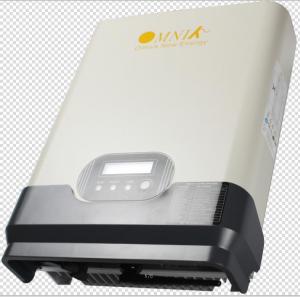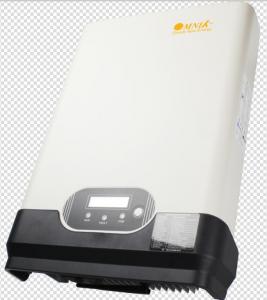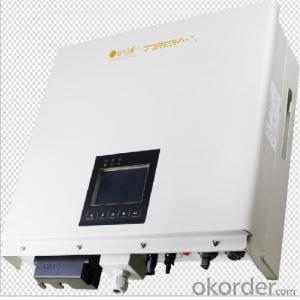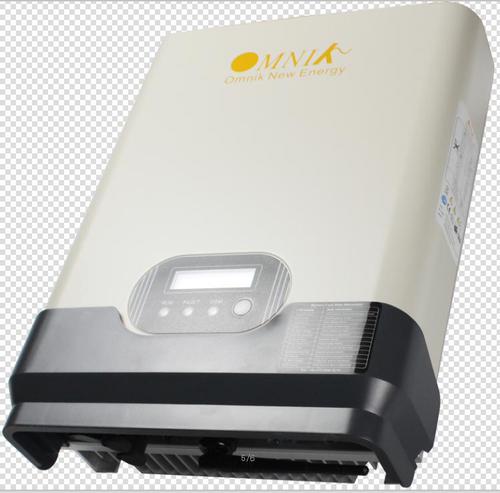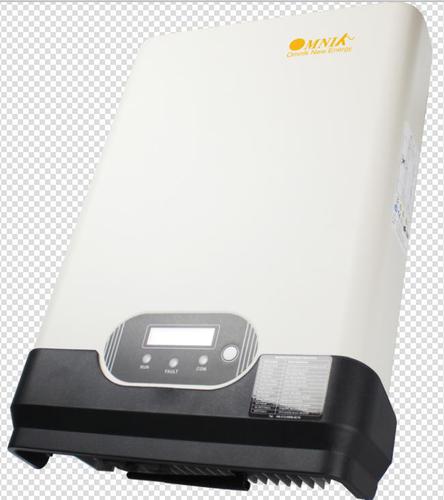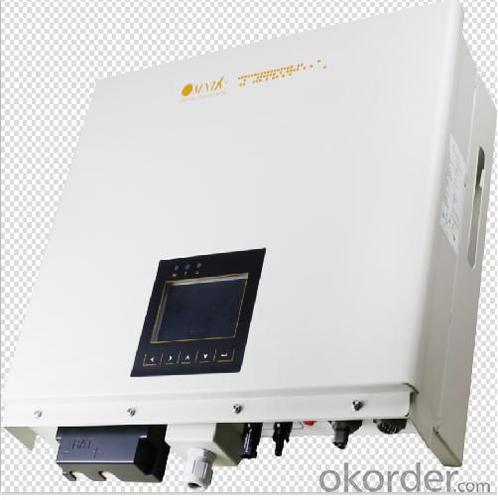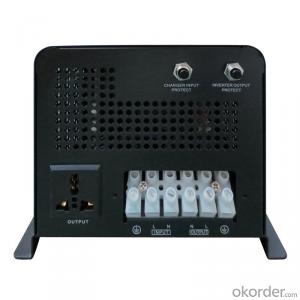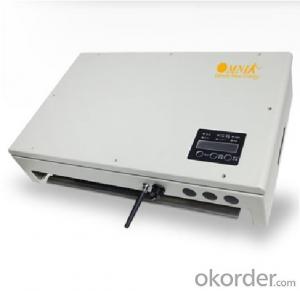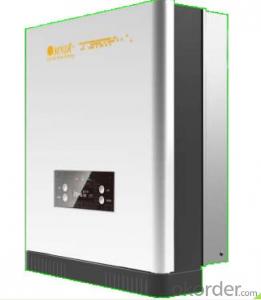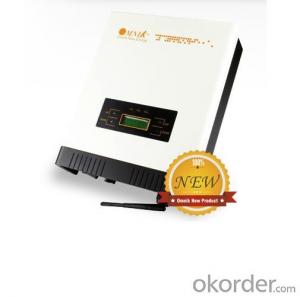Rec Solar Inverter On Grid Omniksol-3.0k-TL
- Loading Port:
- Shanghai
- Payment Terms:
- TT OR LC
- Min Order Qty:
- -
- Supply Capability:
- 3000 pc/month
OKorder Service Pledge
OKorder Financial Service
You Might Also Like
Omnik new energy solar inverter
Omniksol-2.0k-TL Photon Efficiency up to 3kW
in the world------ Photon tested Jan. 2012.
Omniksol-3k-TL
Futures
Transformerless design, high efficiency (Max.97.6%,Euro. 97.0%)
Multi MPPT channels
High MPP tracking accuracy(>99.9%)
Wide DC input range(120-590 Vdc), compatible with different
module technologies
Easy wiring, installating and operating
IP 65 design, suitable for indoor and outdoor installation
5 years warranty(10~25 years as option)
technical data:
Type | Omniksol-3.0k-TL | Omniksol-4.0k-TL | Omniksol-5.0k-TL |
Max. PV-Generator Power [W] | 3400 | 4500 | 5000 |
Max. DC voltage [V] | 590 | 590 | 590 |
MPPT DC voltage Range [V] | 150-500 | 150-500 | 150-500 |
Turn off DC voltage [V] | 120 | 120 | 120 |
Max. DC Current [A] | 36 | 36 | 36 |
Nominal DC Current [A] | 28 | 33 | 33 |
Number of DC Connection | 2 | 2 | 2 |
DC-Connection | MC4 | MC4 | MC4 |
Number of MPP trackers Turn on Power [W] | 2 | 2 | 2 |
Turn on power(W) | 10 | 10 | 10 |
- Q: What is the role of a solar inverter in maximizing solar panel output?
- The role of a solar inverter in maximizing solar panel output is to convert the direct current (DC) electricity generated by the solar panels into alternating current (AC) electricity that can be used in our homes and businesses. Additionally, the inverter ensures that the solar panels operate at their maximum power point, optimizing their efficiency and output. It also monitors and controls the flow of electricity, ensuring safety and preventing any damage to the solar panels or the electrical system.
- Q: Can a solar inverter be used with a solar-powered street lighting system?
- Yes, a solar inverter can be used with a solar-powered street lighting system. A solar inverter is responsible for converting the direct current (DC) produced by solar panels into alternating current (AC) that can be used to power electrical devices. In the case of a solar-powered street lighting system, the solar inverter can convert the DC power generated by the solar panels into AC power to operate the street lights. This allows the system to efficiently utilize the energy generated by the sun and provide reliable lighting for the streets.
- Q: What is the maximum DC input current of a solar inverter?
- The maximum DC input current of a solar inverter can vary depending on the specific model and its design. However, in general, the maximum DC input current of a solar inverter is determined by its capacity and is usually specified by the manufacturer.
- Q: What are the key features to consider when purchasing a solar inverter?
- When purchasing a solar inverter, some key features to consider are the capacity and efficiency of the inverter, its compatibility with your solar panel system, the type of inverter technology used (such as string or microinverters), the warranty and reliability of the brand, and any additional features or smart capabilities offered by the inverter.
- Q: Can a solar inverter be used with different types of tracking algorithms?
- Yes, a solar inverter can generally be used with different types of tracking algorithms. Solar inverters are designed to convert the direct current (DC) generated by solar panels into alternating current (AC) for use in homes or businesses. The tracking algorithms, such as single-axis or dual-axis tracking, are responsible for optimizing the output of solar panels by adjusting their tilt and orientation according to the sun's position. Solar inverters are typically compatible with various tracking algorithms, allowing flexibility in system design and maximizing energy generation.
- Q: Can a solar inverter work during a power outage?
- No, a solar inverter cannot work during a power outage unless it is specifically designed with a backup power supply or battery storage system.
- Q: What are the potential risks of over-discharging a battery connected to a solar inverter?
- The potential risks of over-discharging a battery connected to a solar inverter include reduced battery lifespan, decreased battery performance, and potential damage to the battery cells. Over-discharging can lead to deep cycling, causing the battery to degrade faster and lose its capacity to hold a charge effectively. This can result in shorter backup power duration during periods of low solar generation. Additionally, excessive discharge can cause irreversible damage to the battery cells, leading to reduced overall battery performance and potential safety hazards.
- Q: Can a solar inverter be used in regions with high levels of electromagnetic interference?
- Yes, a solar inverter can be used in regions with high levels of electromagnetic interference. However, it is important to ensure that the solar inverter is designed and manufactured to have proper electromagnetic compatibility (EMC) measures in place. These measures help to minimize the impact of electromagnetic interference on the operation and performance of the solar inverter.
- Q: Can a solar inverter be used in remote areas without access to the grid?
- Yes, a solar inverter can be used in remote areas without access to the grid. Solar inverters are designed to convert the DC power generated by solar panels into AC power that can be used to run electrical appliances. In remote areas, where there is no grid connection, solar inverters can be used in off-grid or standalone systems to provide electricity for various purposes, such as lighting, charging batteries, or powering small appliances. These systems typically include solar panels, batteries for energy storage, and the solar inverter to convert the stored energy into usable AC power.
- Q: Are there any government incentives or rebates available for solar inverters?
- Yes, there are various government incentives and rebates available for solar inverters. These incentives vary from country to country and even within different regions. They can include tax credits, grants, and rebates offered by federal, state, or local governments. It is recommended to check with relevant government agencies or consult with a solar installer to determine the specific incentives available in the desired location.
Send your message to us
Rec Solar Inverter On Grid Omniksol-3.0k-TL
- Loading Port:
- Shanghai
- Payment Terms:
- TT OR LC
- Min Order Qty:
- -
- Supply Capability:
- 3000 pc/month
OKorder Service Pledge
OKorder Financial Service
Similar products
Hot products
Hot Searches
Related keywords
